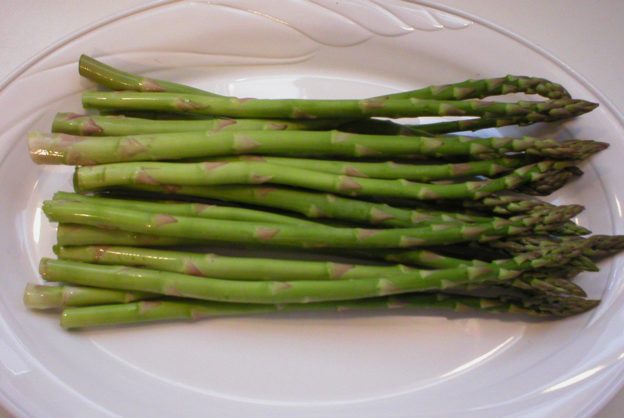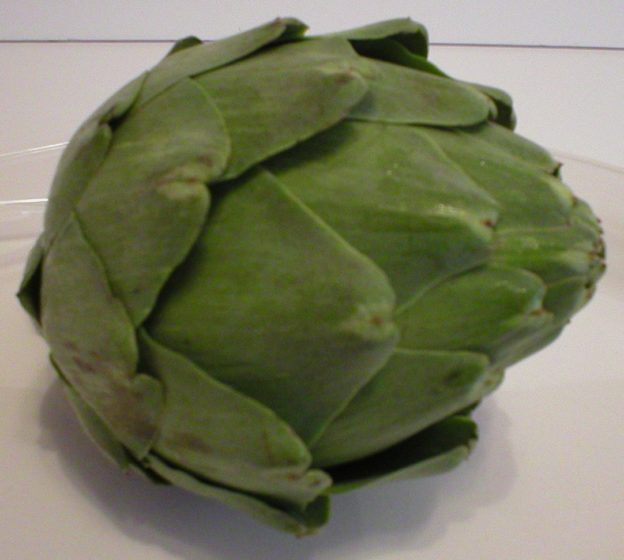If you need to know something about asparagus, you’re in the right place! Below is a lot of information from what asparagus is and how it grows to suggested recipe links and everything in between. I hope this helps!
Enjoy,
Judi
Asparagus 101 – The Basics
About Asparagus
Asparagus spears, as we find them in grocery stores, are actually young shoots of a plant that (if not harvested) would grow into a large fern-like structure. Most asparagus commonly sold in the United States is green. In Europe, asparagus is usually grown in a different manner yielding a white, mild flavored variety of the plant. Creative farmers have recently learned how to cultivate a purple variety of asparagus that is starting to be found in some grocery stores.
Asparagus is native to Africa, Asia and Europe. Over time, it spread to North and South America, New Zealand, and Australia. China, Peru and Mexico currently produce most of the world’s asparagus crop. Most of the asparagus grown in the United States is produced in California, Washington and Michigan.
Nutrition Tidbits
Asparagus is an excellent source of Vitamin K, assorted B-Vitamins, copper, selenium, and Vitamins C and E. It is also a good source of fiber and other vitamins and minerals including manganese, calcium, potassium, phosphorus, iron, magnesium, and zinc. Of course, being a plant food, it has no cholesterol. One cup of raw asparagus has a mere 27 calories.
Some people express concern about a particular odor in their urine after eating asparagus. This is nothing to be concerned about. It’s actually due to the breakdown of a particular antioxidant in asparagus that has numerous health benefits, especially in aerobic metabolism. In fact, researchers have identified almost 100 different phytonutrients in asparagus that make this vegetable a unique nutritional workhorse, unlike any other. The antioxidants in asparagus make it a powerful anti-inflammatory food.
How to Select Asparagus
When shopping for asparagus, look for firm, brightly colored stalks. Opt for thinner stalks because they are more tender than the thicker ones. Choose stalks with closed and deeply colored tips as they will be fresher. Also, opt for ones with less woody, tough stems so there will be less to discard when you prepare them.
How to Store Asparagus
Store asparagus in the refrigerator and use it as soon as possible after bringing it home. There are two suggested ways to store asparagus while in the refrigerator: (1) Wrap the ends in a damp paper towel, or (2) Stand the stalks upright in a container wide enough to hold them. Add enough water to allow the bottoms of all the stalks to rest in about one inch of water. The upper stalks may be loosely covered with a plastic bag. Change the water if it starts to look cloudy.
Here’s a video on “The Best Way to Store Asparagus” …
How to Freeze Asparagus
To freeze asparagus, wash it, then remove the woody ends and cut it into desired lengths. Blanch it in boiling water for 1 to 3 minutes, depending on the thickness of the stalks and length of the pieces. If steam-blanching is preferred, place the asparagus pieces in a steamer basket over boiling water. Cover with a tight-fitting lid and allow to steam for 3 to 6 minutes, depending on the thickness and length of the stalk pieces.
Immediately transfer the blanched asparagus to a bowl of ice water and allow it to cool completely. Drain and place the asparagus in an air-tight freezer container.* It may be stored in the freezer for 8 to 12 months. It is not mandatory to thaw the asparagus pieces before cooking.
* To keep the pieces from bunching up and freezing into one big lump, you could place your blanched and drained asparagus pieces on a tray. Place the tray in the freezer for one or two hours until the asparagus pieces are frozen. Then transfer them to a container or freezer bag for storage in the freezer.
Blanching vegetables before storing them in the freezer is an important step in stopping the enzyme activity which will continue to age them even in the freezer. Some people choose to freeze vegetables without blanching them first. If you opt to do this, be sure to label them with the date and use them within four to six weeks. Beyond that, they will start to deteriorate with changes in color, texture, and flavor.
Fresh vs Frozen vs Canned
Asparagus is available canned, frozen and fresh in most grocery stores. As is the case with most vegetables, fresh is best with regard to flavor, aroma, texture, and nutritional value. Frozen vegetables are a close second choice with regard to those same aspects and are a wonderful convenience when fresh is not available or you are short on prep time in the kitchen. Canned asparagus spears are found year-round in most grocery stores and can be a good staple food to have available in a pinch. Since the canning process actually cooks vegetables along the way, canned asparagus spears are extremely tender and will not have the crispness of fresh or even frozen asparagus pieces. They simply need to be briefly heated and are ready to serve. However nutritionally speaking, the canned variety comes in last on the list.
How is asparagus usually eaten…raw or cooked?
Asparagus is usually cooked before being eaten; however, the thinner, tender stalks can be enjoyed raw. They can be a nice crunchy addition to a green salad.
How to Prepare Asparagus
Of course, give your asparagus a good wash first. Some people will opt to peel the bottom portion of the asparagus stalks with a vegetable peeler if they are thick and somewhat woody, although this is not mandatory. Cut or break off the woody area toward the bottom of the stalks, and discard or save them for stock. Cut the remaining portion into desired lengths or leave whole.
Cooking/Serving Ideas
Asparagus can be boiled, steamed, sautéed, roasted, pickled, grilled, and included in frittatas, omelets, soups, and stir-fries. Thin, tender stalks can be eaten raw. Most importantly, asparagus cooks up and becomes soft quickly, so less is best when working with asparagus. Thinner stalks take less time to cook than thicker ones, so this is important when determining cooking times.
To boil asparagus, bring water to a boil in a skillet or saucepan. Add prepared asparagus to the pan and boil for 5 to 7 minutes, or until as tender as desired.
To microwave your asparagus, place your prepared asparagus pieces into a microwave-safe dish. Add 2 tablespoons of water, cover, and microwave on high for 4 to 6 minutes, rearranging spears midway to allow them all to cook evenly.
To steam asparagus, lay the stalks in a steamer basket over boiling water. Cover and steam for 5 to 7 minutes, until crisp-tender.
To stir-fry asparagus, cut it into one-inch pieces, and stir-fry it in a wok or skillet with 1 or 2 tablespoons of butter or oil, for 5 to 7 minutes.
To roast asparagus, arrange prepared stalks in a single layer in a large shallow baking pan. Drizzle with 1 or 2 tablespoons of olive oil and sprinkle with salt and pepper. Roast at 425°F for 10 to 15 minutes, until tender, but firm to the bite.
To BBQ asparagus, follow the same preparation method as roasting (above), but lay the asparagus spears on aluminum foil on the BBQ grill.
Quick Ideas for Using Asparagus:
* When cooking asparagus, remove it from the heat a minute or so before you think it is done. It will continue to cook briefly after being removed from the heat.
* Add cooked, cold asparagus to your favorite green salad.
* Add asparagus to your favorite omelet.
* Add asparagus to cooked pasta dressed with some olive oil, herbs and Parmesan cheese.
* Sauté asparagus with garlic, onions, mushrooms, and beans, tofu or chicken. Serve over a bed of rice.
* Save freshly cooked leftover asparagus for use the next day in an egg, pasta, or rice dish.
* Cook asparagus in your favorite way and top it with a little vinaigrette dressing.
* Marinate asparagus with teriyaki sauce, then grill it and sprinkle with sesame seeds.
Herbs/Spices That Go Well With Asparagus
Basil, bay leaf, capers, chervil, chili paste and chili pepper flakes, chives, cilantro, dill, fennel seeds, garlic, ginger, hoisin sauce, hollandaise sauce, horseradish, mint, miso, mustard (Dijon), nutmeg, parsley, pepper, rosemary, sage, salt, sorrel, soy sauce, tarragon, thyme
Other Foods That Go Well With Asparagus
Proteins, Nuts, Seeds: Bacon, beans, eggs, nuts, peanuts and peanut sauce, pine nuts, prosciutto, salmon, sesame, tofu
Vegetables: Artichokes and artichoke hearts, arugula, bell peppers, corn, fennel, greens (salad), leeks, mushrooms, onions, peas, potatoes, shallots, spinach, tomatoes, watercress
Fruits: Avocado, lemon, lime, olives (black), orange
Grains: Bread crumbs, noodles, pasta, polenta, quinoa, rice, whole grains (ie barley, couscous, farro)
Dairy and Non-Dairy: Butter and browned butter, cheese, cream, cream cheese, crème fraiche, Parmesan cheese, yogurt
Other: Honey, mayonnaise, oil, vinaigrette, vinegar, wine (dry white)
Asparagus has been used in: Custards, French cuisine, pizza, quiche, risotto, salads, soufflés, stir-fries, sushi (vegetarian), and tarts (vegetable)
Suggested Flavor Combos:
Pair asparagus with…
Avocado + lime + mint + olive oil
Basil + olives
Bell peppers + eggs + garlic + lemon juice + thyme
Citrus + garlic + herbs (ie parsley, tarragon) + olive oil
Couscous + orange
Fava beans + mint
Garlic + ginger + scallions + sesame + sesame oil + soy sauce + vinegar
Ginger + hoisin sauce + sesame oil + soy sauce
Goat cheese + lemon + olive oil + pistachios
Hazelnuts + Parmesan cheese + parsley
Lemon + Parmesan + risotto
Lemon + pecans + rice
Onions + orange
Sesame + tofu
Recipe Links
Mediterranean Pasta Salad http://www.whfoods.com/genpage.php?tname=recipe&dbid=152
Warm Asparagus Salad http://www.whfoods.com/genpage.php?tname=recipe&dbid=188
5-Minute Healthy Sautéed Asparagus http://www.whfoods.com/genpage.php?tname=recipe&dbid=296
Garlic Shrimp Salad http://www.whfoods.com/genpage.php?tname=recipe&dbid=84
15-Minute Healthy Sautéed Chicken and Asparagus http://www.whfoods.com/genpage.php?tname=recipe&dbid=139
How to Cook Asparagus in the Oven https://www.thekitchn.com/how-to-cook-asparagus-in-the-oven-cooking-lessons-from-the-kitchn-202675
Asparagus, Prosciutto, and Goat Cheese Frittata https://producemadesimple.ca/asparagus-prosciutto-and-goat-cheese-frittata/
Asparagus and Mushroom Tart https://producemadesimple.ca/ontario-asparagus-mushroom-tart/
Breaded Asparagus Spears with Smoked Maple Bacon Dip https://producemadesimple.ca/breaded-asparagus-spears-smoked-maple-bacon-dip/
Asparagus and Cheese Quiches https://producemadesimple.ca/ontario-asparagus-cheese-quiches/
Asparagus Penne Bake https://producemadesimple.ca/ontario-asparagus-penne-bake/
Shaved Asparagus Salad https://producemadesimple.ca/shaved-asparagus-salad/
77 Healthy Ways to Cook With Asparagus https://www.cookinglight.com/food/in-season/cooking-with-asparagus
The 16 Most Delicious Things You Can Do To Asparagus https://www.self.com/gallery/the-most-delicious-things-you-can-do-to-asparagus
30+ Amazing Asparagus Recipes https://www.afamilyfeast.com/asparagus-recipes/
33 Asparagus Recipes for Salad, Pasta, Grilling, and More https://www.bonappetit.com/recipes/slideshow/asparagus-recipes
26 Amazing Asparagus Recipes https://cooking.nytimes.com/68861692-nyt-cooking/999915-26-amazing-asparagus-recipes
About Judi
Julia W. Klee (Judi) began her journey enjoying “all things food” in elementary school when she started preparing meals for her family. That love of food blossomed into a quest to learn more and more about health and wellness as related to nutrition. She went on to earn a BS Degree in Food and Nutrition, then an MS Degree in Nutrition. She has taught nutrition and related courses at the college level to pre-nursing and exercise science students. Her hunger to learn didn’t stop upon graduation from college. She continues to research on a regular basis about nutrition as it relates to health. Her hope is to help as many people as possible to enjoy foods that promote health and wellness.
Resources
https://www.thespruceeats.com/all-about-asparagus-2215775
http://www.whfoods.com/genpage.php?tname=foodspice&dbid=12
https://www.thekitchn.com/the-best-way-to-store-asparagus-203442
https://producemadesimple.ca/asparagus/
https://producemadesimple.ca/savoury-asparagus-recipes-spring/
https://www.ncbi.nlm.nih.gov/pubmed/26592472
Page, Karen. (2014) The Vegetarian Flavor Bible. New York, NY: Little, Brown and Company.


